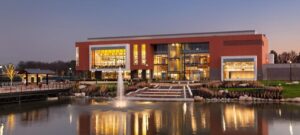
by Dick Hall-Sizemore
In the discussion over the shortage of “affordable” housing, one could point to one company that could be considered the cause of the disappearance of a lot of the affordable housing stock in the Richmond area: Gumenick Properties.
The company has redeveloped an 80-acre tract it owned near Broad St. on the Henrico/Richmond boundary to include apartment buildings; commercial space, including restaurants and fitness centers; and a large, state-of-the-art public library (Henrico County). As reported in today’s Richmond Times-Dispatch, the company is ready to construct its third large apartment complex on the property. It will consist of 398 units, ranging from studios to three bedroom apartments. The rents for its current complexes, which have a maximum of two bedrooms, range from $1,400 to $2,700. It is reasonable to expect the three-bedroom units to exceed this maximum.
The company has been successful in leasing its apartments in this development. The occupancy rates for the other two large complexes, comprising about 700 units, are 97 percent and 98 percent.
The article describes the company’s activities as “transforming an area that was largely undeveloped just a few years ago.” That is not quite accurate, as described later in the article: “The tracts of land where Libbie Mill-Midtown is situated have been in the Gumenick portfolio for more than half a century. A community was originally built there in the late 1940s as a living area for returning World War II veterans. That housing was demolished by 2004 after aging past the point of recovery.” In other words, rather than spend some money to maintain and fix up the property and continue renting to middle and lower-middle class tenants, the company decided to knock everything down and put in a shiny new, upscale community.
This is not the first time that Gumenick Properties has done this. I first became aware of it when it began demolishing older housing stock (apartments and small houses) near Crestview Elementary School. A large community of Vietnamese immigrants (legal) lived in that area because they could afford the rents. After displacing the occupants of those units, the company built newer single family houses and apartments. The rent for an apartment in this area ranges from $1,291 to $1,885 and for a townhouse, $1,623-$2,557.
There was another older apartment complex near Willow Lawn shopping center that was bulldozed and a newer and larger apartment complex put into its place.
There is nothing illegal or nefarious in all this. The company obviously crunched the numbers and concluded that it would be more worthwhile to replace the older housing than to continue maintaining it. In addition, rather than replace those older units with rather plain smaller houses and apartments that lower middle class tenants could afford, it would be more profitable to make the units a little bigger and then throw in some shiny appliances, a pool, and some game rooms to appeal to the “the 20-to-35 age group and young millennials in particular,” who could afford to pay about $2,000 a month.
That is how the capitalist system works. So, when conservatives lament the lack of affordable housing, they need to remember that our economic system is partly to blame. It is more profitable to build for folks that have ready access to money than it is to build for those who don’t have a lot of money.
Anthony Romanello, , executive director for the Henrico Economic Development Authority, obviously did not consider this when he gushed, “We couldn’t be more excited about what’s happening at Libbie Mill. It’s a textbook case for how you can redevelop a property and really create a great place for people to work and live.” It was a good place for working people to live there in the past, as well. They just can’t afford it now.

Leave a Reply
You must be logged in to post a comment.